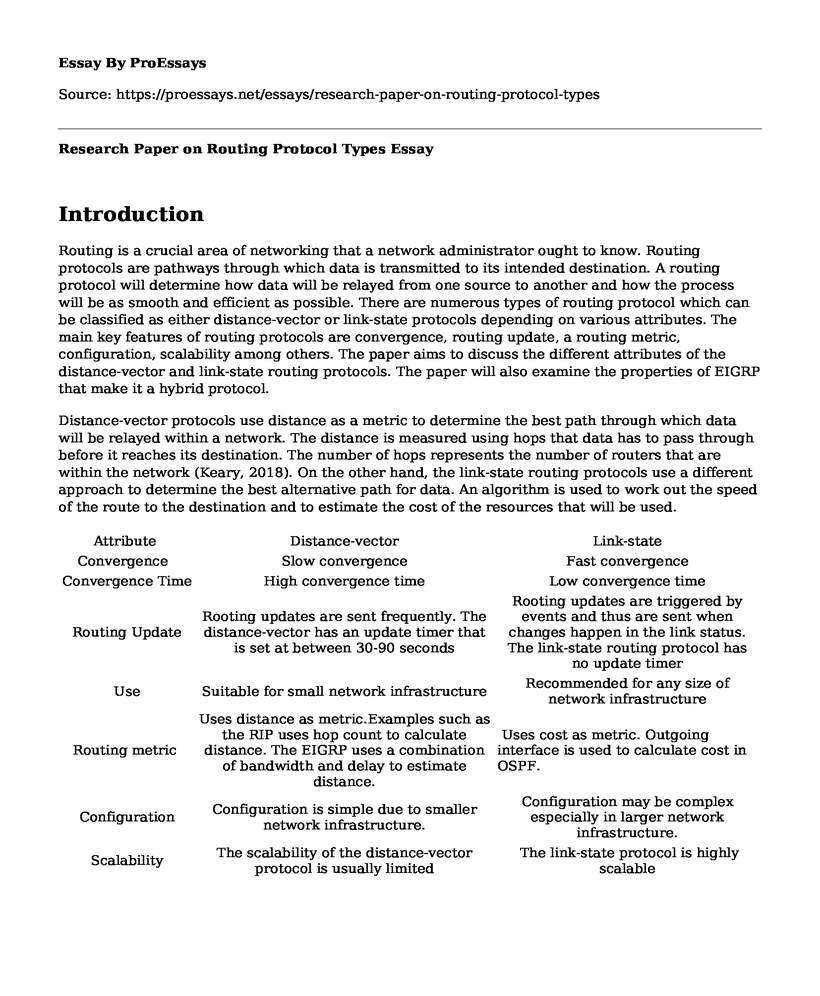Introduction
Routing is a crucial area of networking that a network administrator ought to know. Routing protocols are pathways through which data is transmitted to its intended destination. A routing protocol will determine how data will be relayed from one source to another and how the process will be as smooth and efficient as possible. There are numerous types of routing protocol which can be classified as either distance-vector or link-state protocols depending on various attributes. The main key features of routing protocols are convergence, routing update, a routing metric, configuration, scalability among others. The paper aims to discuss the different attributes of the distance-vector and link-state routing protocols. The paper will also examine the properties of EIGRP that make it a hybrid protocol.Distance-vector protocols use distance as a metric to determine the best path through which data will be relayed within a network. The distance is measured using hops that data has to pass through before it reaches its destination. The number of hops represents the number of routers that are within the network (Keary, 2018). On the other hand, the link-state routing protocols use a different approach to determine the best alternative path for data. An algorithm is used to work out the speed of the route to the destination and to estimate the cost of the resources that will be used.
| Attribute | Distance-vector | Link-state |
| Convergence | Slow convergence | Fast convergence |
| Convergence Time | High convergence time | Low convergence time |
| Routing Update | Rooting updates are sent frequently. The distance-vector has an update timer that is set at between 30-90 seconds | Rooting updates are triggered by events and thus are sent when changes happen in the link status. The link-state routing protocol has no update timer |
| Use | Suitable for small network infrastructure | Recommended for any size of network infrastructure |
| Routing metric | Uses distance as metric.Examples such as the RIP uses hop count to calculate distance. The EIGRP uses a combination of bandwidth and delay to estimate distance. | Uses cost as metric. Outgoing interface is used to calculate cost in OSPF. |
| Configuration | Configuration is simple due to smaller network infrastructure. | Configuration may be complex especially in larger network infrastructure. |
| Scalability | The scalability of the distance-vector protocol is usually limited | The link-state protocol is highly scalable |
Properties of EIGRP
Route protocols are of different types, and the Enhanced Interior Gateway Routing Protocol (EIGRP) is an example of a hybrid protocol. The EIGRP has a combination of both the distance-vector and the link-state routing protocol properties (Azam, 2017). The EIGRP can be categorized as a distance-vector protocol because it has no complete map of the pathway. It is only aware of the information that is relayed directly by its neighbours. This property means that the EIGRP uses routing by rumour because they do not provide details about the routes in the network. The EIGRP is said to be a link-state protocol because events within the network trigger the routing updates. A routing update is only sent when there is any change in the link status. The EIGRP is suitable for large and complex networks because the routing updates are triggered only when there is a change in the topology.
Conclusion
In conclusion, the distance-vector protocol is mainly used in simple networks because it only links information with its connected neighbours but not every available route. The distance-vector protocols are efficient because they send a wide range of information to other neighbouring devices, and thus, they are deployed without the need of being regularly managed. The link-state protocols are suitable for large and complex networks because they form neighbour relationships with all available routes in the network.
References
Azam, W. (2017, January 6). Features and Characteristics of EIGRP Protocol. Retrieved from https://w7cloud.com/features-of-eigrp/
Keary, T. (2018, November 28). Routing Protocol Types - The Ultimate Guide. Retrieved from Comparitech: https://www.comparitech.com/net-admin/routing-protocol-types-guide/
Cite this page
Research Paper on Routing Protocol Types. (2022, Mar 07). Retrieved from https://proessays.net/essays/research-paper-on-routing-protocol-types
If you are the original author of this essay and no longer wish to have it published on the ProEssays website, please click below to request its removal:
- Relationships of Feedback Loops and Information Systems Essay
- Impacts of Internet of Things on Human, Domestic Life, and Military Paper Example
- Essay Sample on Economic Implications of Cloud Computing
- System and Method of Mitigating Cyber Attack Risks Paper Example
- UAE Government Attempts to Formulate and Pass Additional Security Legislation in the IT Sector
- Essay Example on Style Up for Special Occasions - Fashion Blogging
- Virtual Site Visit - Free Essay Sample







